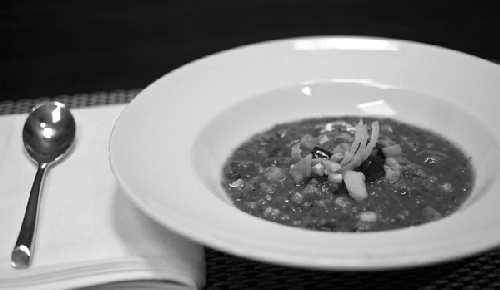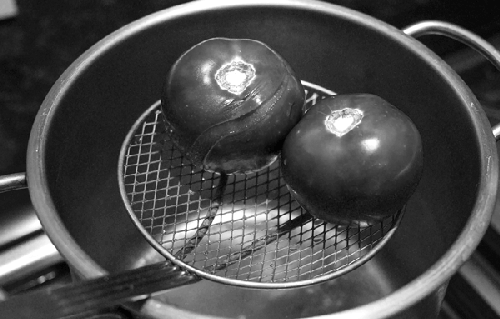
Purée, using an immersion blender or food
processor:
2 large (500g) tomatoes, peeled, with seeds
removed
Transfer the puréed tomato to a large bowl. Add:
1 (150g) cucumber, peeled and seeded
1 cob (125g) corn, grilled or broiled and cut off the
cob
1 (100g) sweet red bell pepper, grilled or
broiled
½ small (30g) red onion, thinly sliced, soaked in water,
and drained
2 tablespoons (20g) olive oil
2 cloves (6g) garlic, minced or pressed through a garlic
press
1 teaspoon (4g) white wine vinegar or champagne
vinegar
½ teaspoon (1g) salt
Stir to combine. Adjust salt to taste and add ground black pepper as desired.
Notes
The weights in this recipe are for the prepared ingredients (i.e., after
removing seeds, trimming stems, or soaking).
If you prefer a smooth gazpacho, purée all of the ingredients at the
end. Or, add a portion of the veggies, purée, and then add the remainder to achieve
a partly smooth, partly chunky texture. It’s all about your
preference!
Gazpacho is one of those dishes that is really about the fresh
ingredients that you have on hand. There’s no mechanical or chemical reason for
these quantities to be written as they are, so add more of this, less of that,
whatever you like to suit your tastes. Try expanding this recipe to include other
ingredients, such as hot peppers or fresh herbs.
Grilling or broiling the corn and bell peppers adds a smoked flavor to
the soup, due to the chemical reactions that take place at higher heat, as we’ll
discuss later in this book. You might find you prefer a “raw” version of this soup.
Or, if you really like the smoky flavor, try adding some “liquid smoke” to amp it
up.
Note:
Whenever you see a recipe calling for a grilled vegetable, you should default to
rubbing it with a light coating of olive oil before grilling it, because this will
prevent the vegetable from drying out while cooking.
How to Peel a Tomato
I have a friend whose boyfriend tried to make her a surprise dinner involving tomato
soup, but he didn’t know how to peel tomatoes. She came home to find her guy frantically
trying to use a vegetable peeler on the tomatoes to no avail...

To peel tomatoes, drop them in boiling water for a few seconds and then pull them out
with tongs or a mesh spider, and then just pull the skins off. You can cut an “x” shape
into the skin before blanching, although I find the skin on some varieties of tomatoes
will pull back regardless, as long as the water is at a full rolling boil. Experiment to
see if it makes a difference!
Purée in a
food processor or with an immersion blender:
2 cups (660g) butternut squash, peeled, cubed, and roasted
(about 1 medium squash)
2 cups (470g) chicken, turkey, or vegetable
stock
1 small (130g) yellow onion, diced and
sautéed
½ teaspoon (1g) salt (adjust to taste)
Notes
As with the gazpacho recipe, the weights are for the prepared
ingredients and only rough suggestions. So, prepare each item individually. For
example, for the squash, peel it, then coat it with olive oil, sprinkle it with
salt, and roast it in the oven at a temperature around 400–425°F / 200–220°C until
it begins to brown. When you go to purée the ingredients, hold back some of the
squash and some of the stock, taste the purée, and see which you think it needs.
Want it thicker? Add more squash. Thinner? Add more stock.
This soup by itself is very basic. Garnish with whatever else you have
on hand that you think might go well, such as garlic croutons and bacon. Or top with
a small dab of cream, some toasted walnuts, and dried cranberries to give it a
feeling of Thanksgiving. How about a teaspoon of maple syrup, a few thin slices of
beef, and some fresh oregano? Chives, sour cream, and cheddar cheese? Why not!
Instead of purchasing items to follow a recipe exactly, try using leftover
ingredients from other meals to complement the squash soup.
If you’re in a rush, you can “jump-start” the squash by microwaving it
first. Peel and quarter the squash, using a spoon to scoop out the seeds. Then, cube
it into 1–2″ / 3–5 cm pieces, drop it into a glass baking pan that’s both oven and
microwave safe, and nuke it for four to five minutes to partially heat the mass.
Remove from microwave, coat the squash with olive oil and a light sprinkling of
salt, and roast it in a preheated oven until done, about 20 to 30 minutes. If you’re
not in a rush, you can skip the peeling step entirely: cut the squash in half, scoop
out the seeds, add oil and salt, roast it for about an hour (until the flesh is
soft), and use a spoon to scoop it out.
To cut thick gourds such as squash and pumpkins, use a large chef’s
knife and a mallet. First, slice off a thin piece of the gourd so that it lies flat
and doesn’t roll, then gently tap the knife blade through the
gourd.
